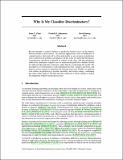Why is my classifier discriminatory?
Author(s)
Sontag, David; Johansson, Fredrik D.
DownloadPublished version (471.6Kb)
Publisher Policy
Publisher Policy
Article is made available in accordance with the publisher's policy and may be subject to US copyright law. Please refer to the publisher's site for terms of use.
Terms of use
Metadata
Show full item recordAbstract
© 2018 Curran Associates Inc..All rights reserved. Recent attempts to achieve fairness in predictive models focus on the balance between fairness and accuracy. In sensitive applications such as healthcare or criminal justice, this trade-off is often undesirable as any increase in prediction error could have devastating consequences. In this work, we argue that the fairness of predictions should be evaluated in context of the data, and that unfairness induced by inadequate samples sizes or unmeasured predictive variables should be addressed through data collection, rather than by constraining the model. We decompose cost-based metrics of discrimination into bias, variance, and noise, and propose actions aimed at estimating and reducing each term. Finally, we perform case-studies on prediction of income, mortality, and review ratings, confirming the value of this analysis. We find that data collection is often a means to reduce discrimination without sacrificing accuracy.
Date issued
2018Department
Massachusetts Institute of Technology. Department of Electrical Engineering and Computer Science; Massachusetts Institute of Technology. Computer Science and Artificial Intelligence LaboratoryJournal
Advances in Neural Information Processing Systems
Citation
Sontag, David and Johansson, Fredrik D. 2018. "Why is my classifier discriminatory?." Advances in Neural Information Processing Systems, 2018-December.
Version: Final published version